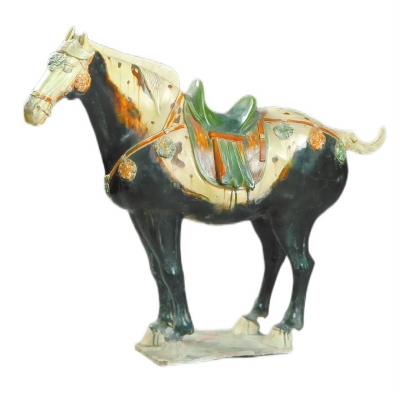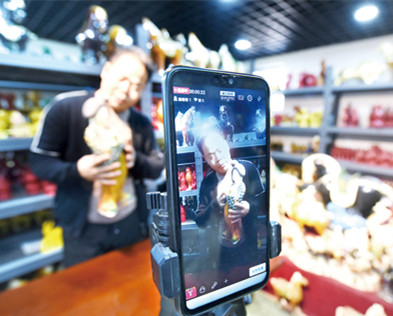
Tangsancai, or Tang tri-coloured glazed pottery, is a type of low-melting glazed pottery featuring prominent yellows, browns, and greens that was developed during the Tang Dynasty (C.E. 618 to 907). Tangsancai artefacts were first unearthed in Nanshishan Village, Mengjin County, Luoyang City, Henan Province, in modern times, and more have been discovered in Luoyang than in any other city in China. Production resumed in Nanshishan at the end of the Qing Dynasty (C.E. 1636 to 1912), a large number of small companies and workshops appeared in the village in the mid-1980s but decreased sharply in the 1990s, and the industry began to boom in the hamlet again when a group of representative cultural inheritors developed production techniques that make it possible to make high-quality modern versions of Tangsancai in 2016 with the support of the local government.

In recent years, China’s e-commerce boom and the emphasis that has often been placed on local characteristic industries in its rural areas in conjunction with tourism have helped power vigorous development of Nanshishan’s distinctive Tangsancai industry, injected new vitality into the ancient artform while preserving it, and enabled the village and its residents become more prosperous.
Nanshishan area native Wang Mengmeng moved to Jiangsu Province on China’s east coast in search of work opportunities after graduating from a secondary technical school. He returned to Luoyang and began working in the home furnishing industry after experiencing a number of ups and downs and ultimately launched a Tangsancai business in Nanshishan in 2016.
“In the old days, Tang tri-coloured glazed pottery was mostly sold in physical stores in scenic areas near Luoyang,” he noted in 2020 while explaining that the people who made it were starting to be in urgent need of more sales avenues.
Wang began pursuing e-commerce in response to the situation and was determined to thrive in the industry. He soon launched his first online store on the Taobao platform, but things were not as easy as he initially expected.
“Tangsancai is not widely known, so sales performance was anything but promising,” the businessman stated.
At the end of 2016, just as he began to get frustrated with his attempts at boosting sales with e-commerce, a Chinese American bought a 1.2-m-high ceramic lion from him for RMB30,000, around RMB20,000 of which was profit, which increased his confidence in the undertaking considerably.
Wang operates online stores on a variety of platforms, including major shopping websites, logs approximately RMB2 million of annual turnover, and even exports products to Europe and the U.S. as of 2020. His outstanding performance has made him a popular figure in Nanshishan. Many residents ask him for help with Tangsancai sales, and the village’s Tang tri-coloured glazed pottery industry has forked into two major areas of concentration under the leadership of himself of other local business leaders – production and sales.
Nanshishan’s inhabitants determined that it would be necessary to create new products if the time-honoured ceramics style was going to experience further development as an industry, however. Wang, therefore, created a specialised R&D team dedicated to designing Tangsancai with greater beauty and that is more fashionable and appeals more to younger people’s aesthetic tastes and sensibilities. He has also spearheaded efforts to create Tangsancai-style decorative objects and automobile accessories in order to expand the market.
Many Nanshishan residents have experienced concrete benefits by participating in the Tangsancai industry. A man in his early 40s named Wang Yule is the head of a business that produces the Tang-style glazed pottery and is committed to reviving it. He mentioned that the company generates an average of around RMB100,000 of profit per annum selling the time-honoured crafts, while Gao Heng, an inhabitant of the village who runs a larger factory, stated that his company makes more than RMB200,000 of profit a year.
“The number of manufacturing enterprises and workshops engaged in the Tangsancai industry in the village peaked at over 200, and there are 72 at present,” remarked Gao Jian, head of the local village. “They generate a total of around RMB300 million of output value per year.”
Towns and villages engaged in the Tang tri-coloured glazed pottery industry have tended to experience problems such as small-scale development, singular product structures, and a lack of talent and innovation. The local government, therefore, proposed developing Nanshishan into a culture and tourism village that draws on its tradition of producing Tangsancai in order to facilitate an overhaul and transformation.
Towns and villages that produce decorative arts and handicrafts may want to make greater efforts to explore new growth models while inheriting and protecting their cultural traditions. Closer attention can be paid to the market so that new offerings that meet corresponding demands can be developed. A team of master craftspeople can be trained to help propel the development of such places, a greater degree of customisation can be offered, and visitors can be given the opportunity to make their own creations. Local governments can combine distinctive resources, delve deep into traditional culture, upgrade their industries and integrate tourism into them, and utilise new intelligent platforms in order to transform and upgrade these types of towns and villages so that new, optimised configurations can emerge and residents can become more prosperous.
![427aa6da-17fc-4382-b372-ba07d2bb479e[0].png](http://www.wfpchinacoe.net/pic/2023-04/23/85247738_a4563079-3c4d-4548-91fb-ce8a3930172a.png)
For more information, please contact WFP China COE (wfpcn.coe@wfp.org)
Category
Nanshishan Village Overhauls Distinctive Tang Tri-coloured Glazed Pottery Industry
Contributor
Nanshishan Village Overhauls Distinctive Tang Tri-coloured Glazed Pottery Industry
Country
Story

